In the Moment with 'Aziz Ansari: Right Now'
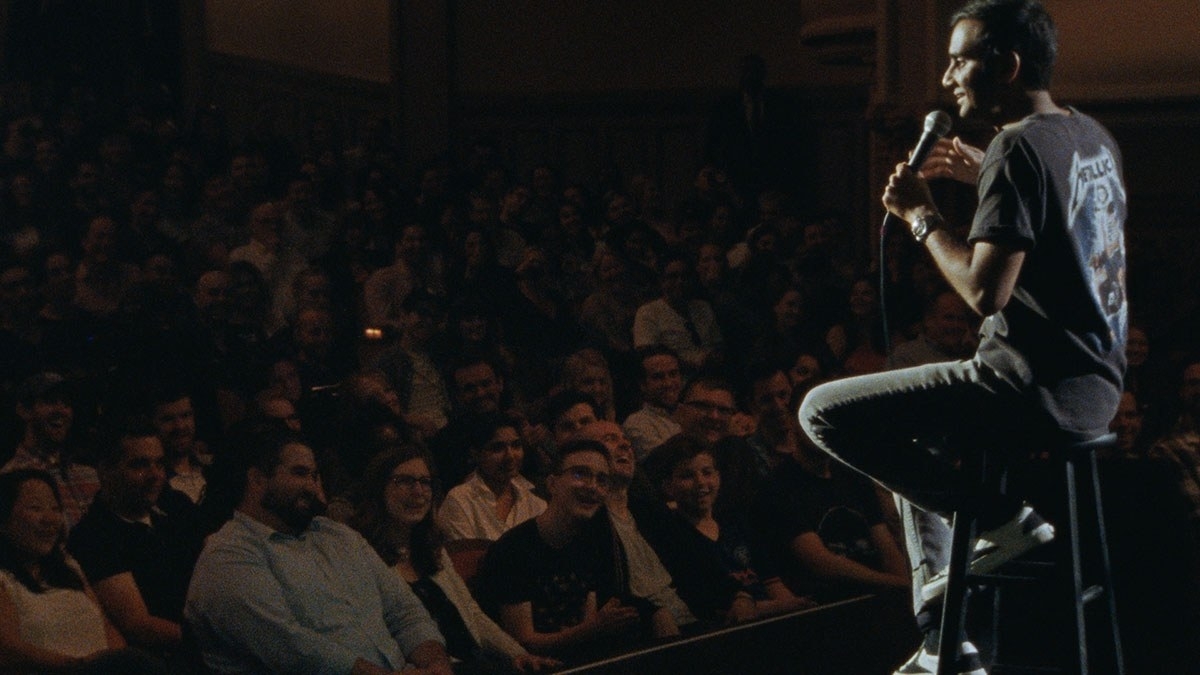
Spike Jonze and Aziz Ansari were specific about the angles that they preferred and what would work best for the show. Image courtesy of Netflix.
One has to give Aziz Ansari (Master of None) credit as he opens his stand-up comedy special Aziz Ansari: Right Now on Netflix by addressing the sexual misconduct allegations against him. The 65-minute long performance is an amalgamation of four shows captured at the Brooklyn Academy of Music on May 16, 17 and 18 in 2019 under the direction of Spike Jonze (Her) with Jason Baum (Kendrick Lamar: Humble) serving as a producer and Autumn Durald Arkapaw (The Sun Is Also a Star) looking after the cinematography. “Aziz has been developing his routine since late last year in the form of the Road to Nowhere tour,” explains Baum. “He and Spike have been good friends for a long time and it was just a natural conversation for them to collaborate. Spike had never directed a stand-up comedy special before and that must have been exciting for the both of them.” Jonze approached Baum about being part of the project. “Aziz Ansari’s Modern Romance is one of my favorite books to have come out over the past few years. It’s so observant, smart and funny. I was personally up for the challenge of producing something a little different as I never produced a stand-up comedy special or worked with Netflix before.”
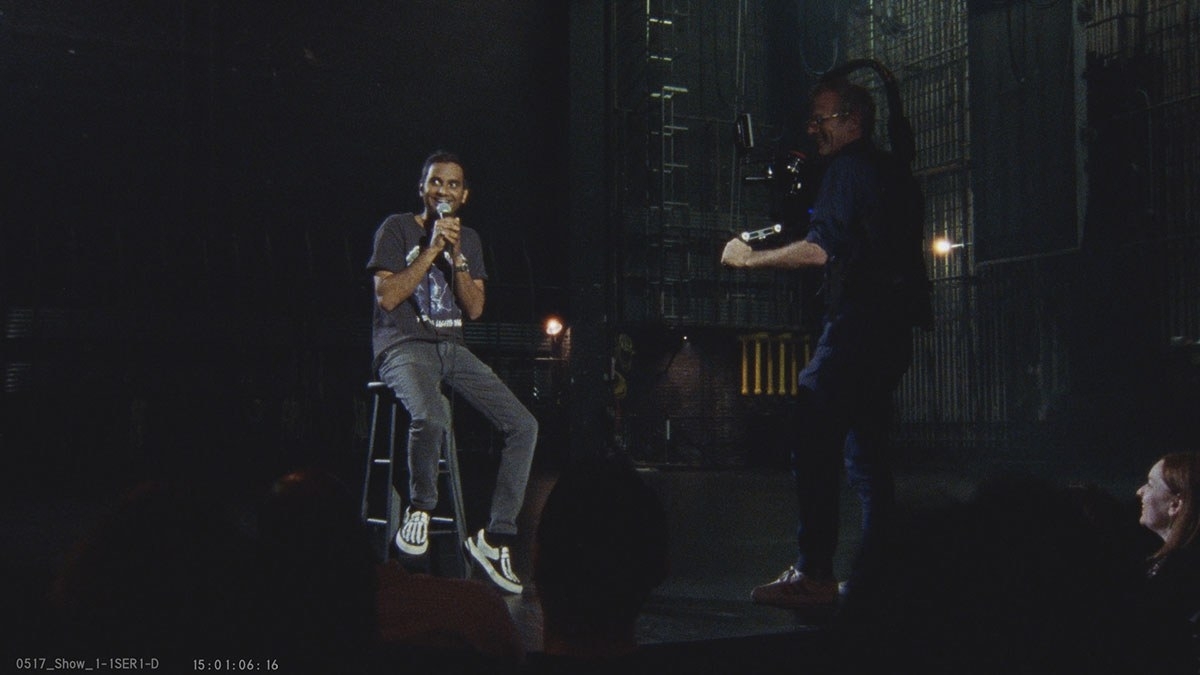
Six Arri 416 cameras were used to capture four shows over the period of three nights for the stand-up comedy special. Image courtesy of Netflix.
The experience was also unique for Durald Arkapaw. “Not often do you get a chance to shoot a live comedy show with six film cameras and with 400’ mags! It is one of my favorite experiences, and my crew has expressed that sentiment as well.” The AFI Conservatory cinematography program graduate previously collaborated with Jonze on another live show. “Spike is a fantastic director and very clear on what feeling the visuals should have and what he likes. Spike and Aziz were on the same page regarding the look and we had a few discussions on how to achieve that in the unique space.” Reference frames were captured when scouting the Brooklyn Academy of Music. “Spike and Aziz were specific about the angles that they preferred and what would work best for the show. It was discussed further between all of us and the editor Jeff Buchanan once we were in the space. Spike and Aziz gravitated towards some references from the 1970s, and we discussed how to achieve that feel; they wanted the space to feel approachable and real, not manipulated. It was an ongoing conversation about lighting that evolved into something really layered with texture.”
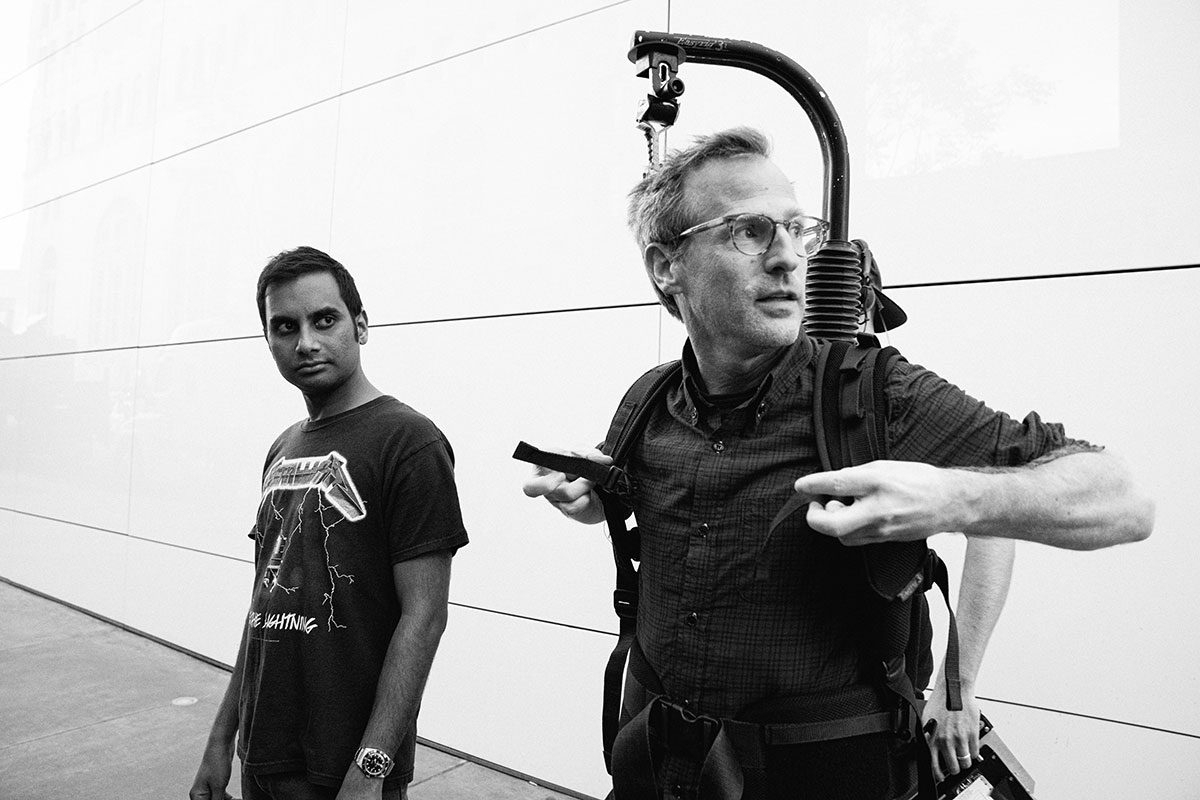
Aziz Ansari and Spike Jonze get ready to film another show. Image courtesy of Marcus Price.
Super 16 was the footage format of choice. “Shooting on film was an idea from very early in the creative process,” explains Baum. “We didn’t want to record a typical Netflix stand-up special with standard coverage and a fleet of 4K digital cameras. Film allowed us to create something that felt raw and unpolished. Specifically, 16mm allowed the image to have a little more character and texture than 35mm. It really felt like a throwback to an older approach of recording live events.” The film stock was KODAK VISION3 500T Color Negative Film 7219, pulled one stop and rated at 250. “We did a few tests leading up to the shoot that were developed by Kodak’s lab in Long Island City. Metropolis Post in Manhattan then scanned that for us to evaluate while we were prepping on location. However, when it came to production, we had a very tight post timeline, so we made the decision to courier the negative to FotoKem in Los Angeles every night. FotoKem could then take charge of the entire post-production workflow from developing, scanning to online and final color.”
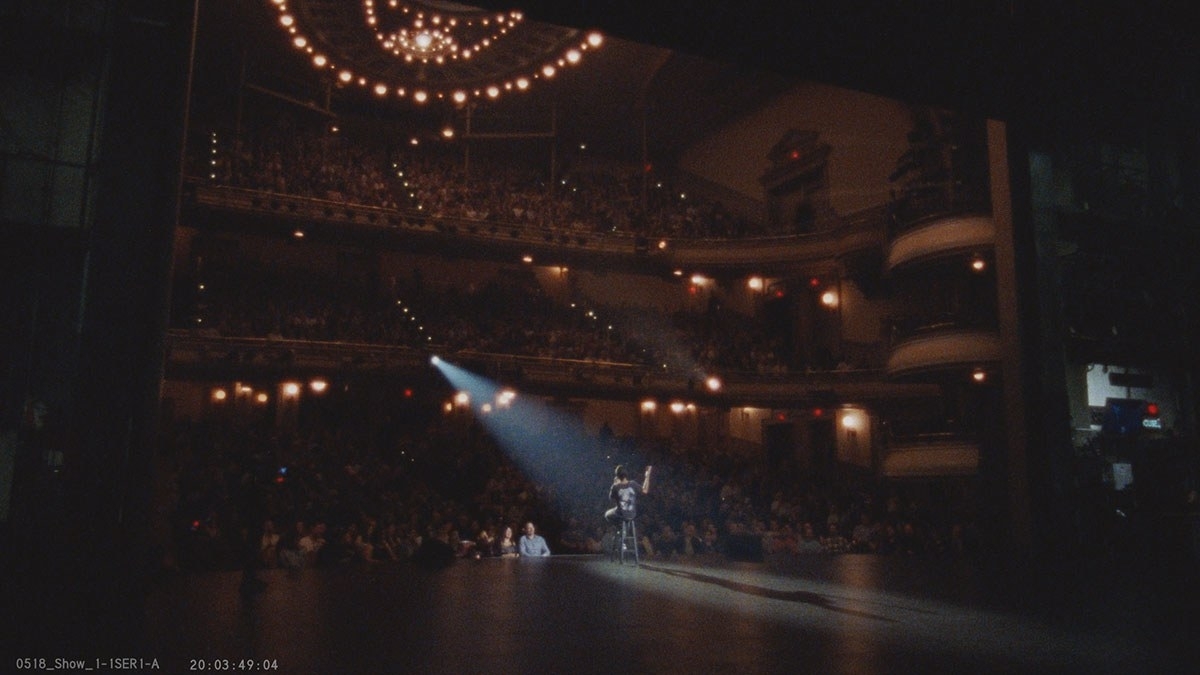
The architecture of the Brooklyn Academy of Music and vintage practicals on the seating side added great detail in the wide shots. Image courtesy of Netflix.
“Arri CSC in New York supplied us with six Arri 416 cameras,” remarks Durald Arkapaw. “We had a mixed bag of 16mm Canon and Cooke short and long zooms with various ranges from 8mm to 210mm as well as a set of Zeiss Distagon 16mm primes. I always favour vintage lenses. Spike and I loved the 8mm, which was also the hero lens he operated onstage with Aziz. We used Scenius Profile lights, Solaframe Spot, VL4000 Spot, Lekos and a few practical fixtures on the stage.” Lighting the historical theatre was a welcomed challenge. “There was a lot of depth on the stage and the brick walls had beautiful texture. The existing architecture and vintage practicals on the seating side added great detail in our wide shots. I enjoyed using a mixture of hard and soft light throughout that space.” It was important to Jonze and Ansari that space feel raw and soulful. “I’m very happy they wanted to take that approach because I think where we landed with the lighting is quite lovely and nostalgic. We worked with a lighting designer, Spike Brant. We had previously done a job with him and his team, so there was already a great rapport. 16mm film has about half the resolution of 35mm, so in some circumstances [often wide shots] you want more contrast in order to get more clarity in the image. We made sure there were units in all the right places in order to fill the shadows and pop the elements we wanted to accentuate. Everything was on a board, and we were able to make changes on the fly when needed.”
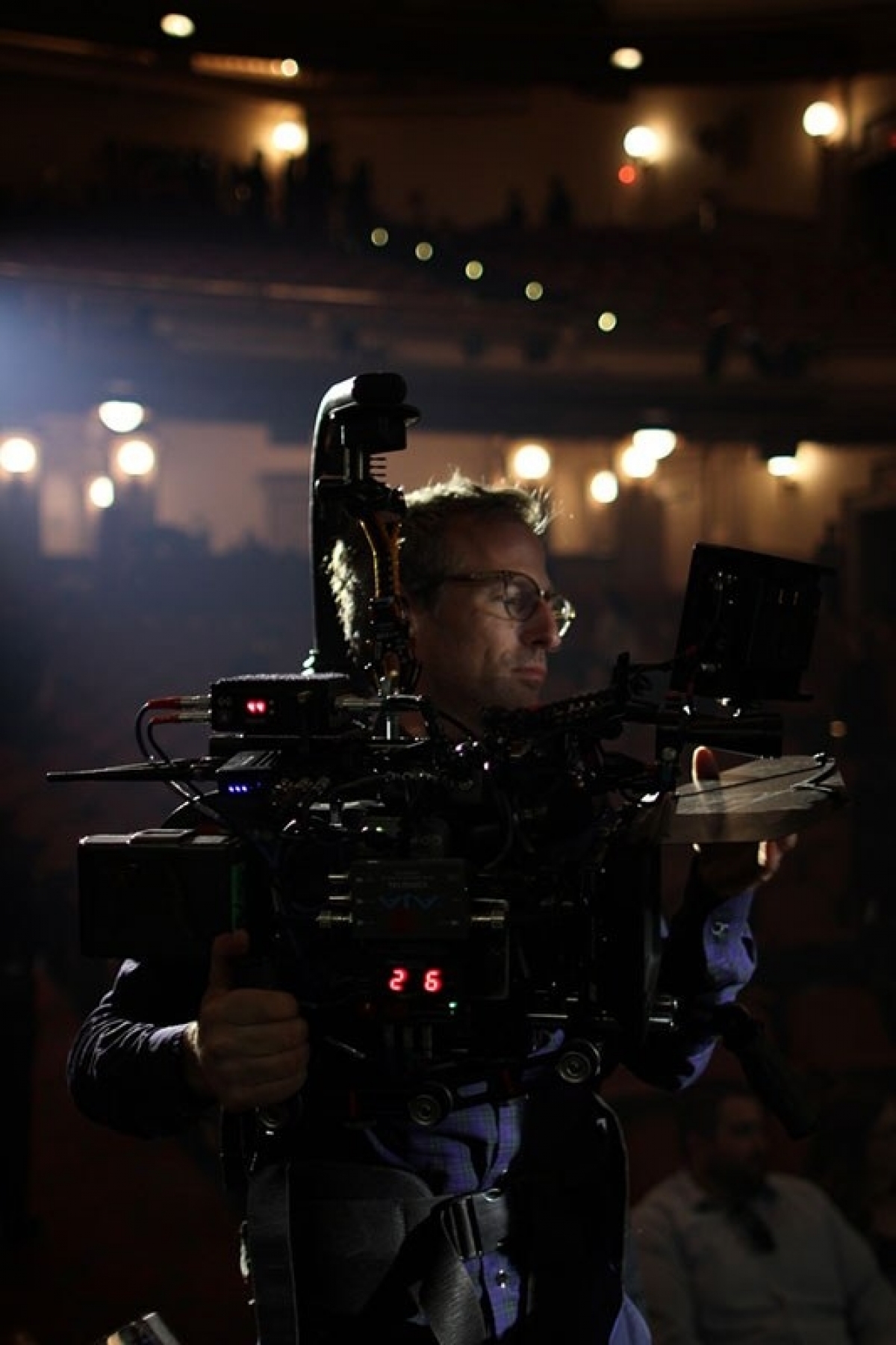
Filmmaker Spike Jonze had never directed a stand-up comedy special and has been good friends with Aziz Ansari for a long time. Courtesy of Autumn Durald Arkapaw.
“Al Arnold at FotoKem made a LUT for a test that we did prior to the shoot,” states Durald Arkapaw. “We used that on the dailies and everyone was happy with it. In the final grade we tweaked that LUT to taste and to pop certain tones we wanted highlighted. Spike has great notes in the grade so it was a nice process.” Six Arri 416 cameras needed to be positioned without being captured in frame. “Camera positions were figured out after discussing options on the scout. Spike and Aziz knew what they wanted out of each shot. On the first night we looked at all our cameras and tweaked them to our liking. During our pre-light we used an Arri Alexa Mini just for viewing a couple different angles and lenses with lighting.” Keeping things interesting was editing the four shows into a single performance. “Continuity was a concern, but only to a certain extent,” notes Baum. “Most of the time you are watching Aziz speak so you can easily steal shots from between nights. However, we didn’t really have to do too much creative stitching. The majority of the edit is from one, maybe two shows.” Visual effects were minimal. “Shooting a live event means that there are issues that you are unable to fix in the moment. We always anticipated needing a team to help patch the multiple nights together and remove continuity issues. Electric Theatre Collective’s offices in L.A. and London came in to help erase those potential distractions.”
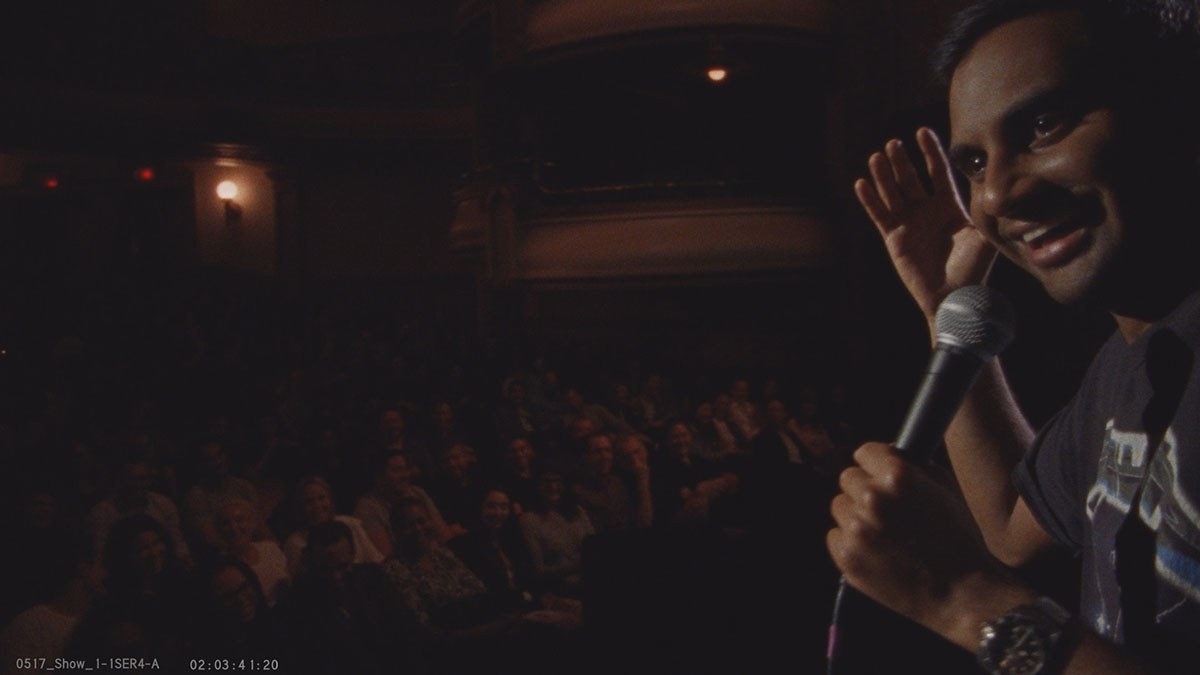
Shooting on Super 16mm helped to make the imagery feel raw and unpolished. Image courtesy of Netflix.
“Colorist Al Arnold and I’ve worked on two of my features and various other projects,” remarks Durald Arkapaw. “My A camera team was 1st AC Braden Belmonte and 2nd AC Brendan Russell, and Spike operated A camera. My gaffer was Charlie McNamara and Key Grip was Greg Cahill.” Along with capturing the visuals, recording the production sound was important. “The biggest challenge for sound was mic-ing the audience,” notes Baum. “This show has much more crowd work than a typical special, and we tried to hide as many mics as possible since we never knew who Aziz would choose each night.” Live events are always difficult. “There are no do-overs and communication among the crew can be difficult. Thankfully, we had four shows over three nights to work out any kinks. Remember with 16mm, there are only 400-foot mags available, and they give you just over 11 minutes of recording time. Our 1st AD, Chad Nicholson, really helped to keep us on track by figuring out how to stagger the camera reloads so that we didn’t have multiple cameras switching mags at the same time, or we weren’t doing it during the same joke across different shows. This attention to detail really helped us combat the biggest drawback in choosing film for this project.”
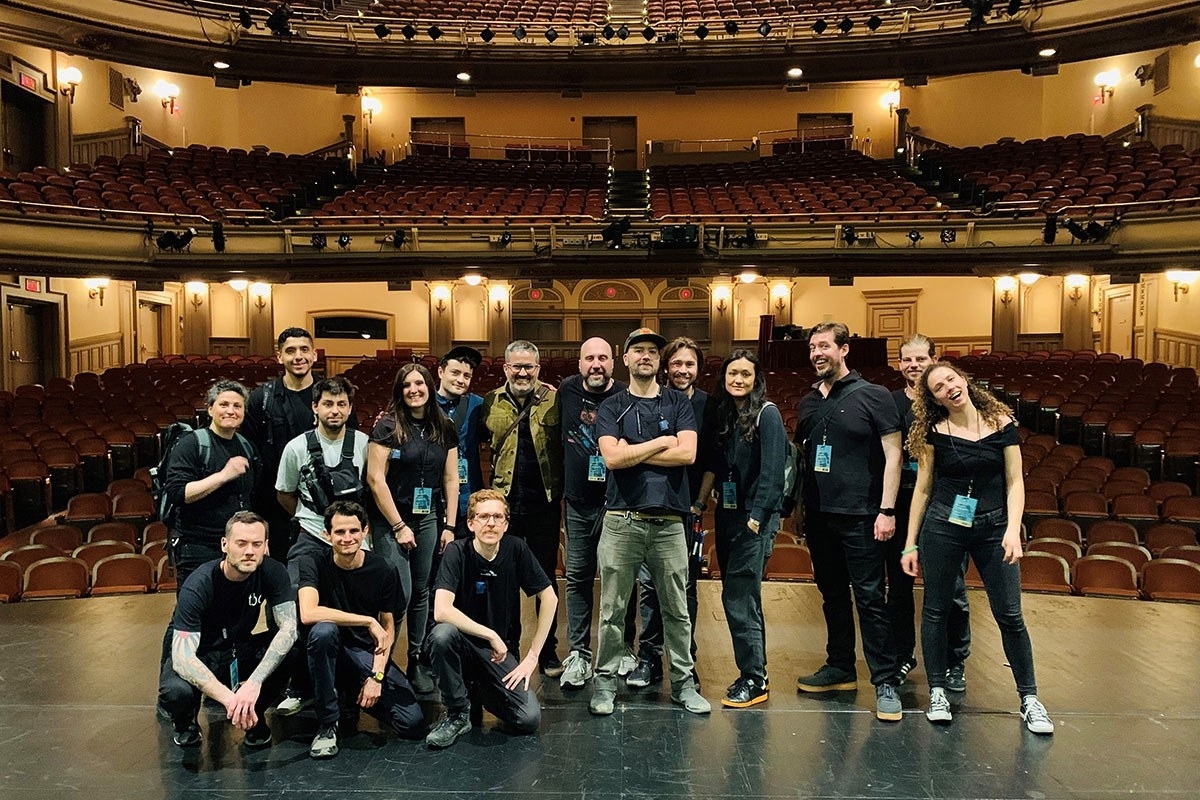
Back row (left to right): Beka Venezia - F Camera 1st AC; Gavin Fernandez - D Camera 1st AC; Sachi Bhara - Film Loader; Carrie Wills - Head Film Loader; Andrew Fletcher - A Camera Operator; Gerard Sava - C Camera Operator; Braden Belmonte - A Camera 1st AC; Brendan Russell - A Camera 2nd AC; Bradley Grant - B Camera 1st AC; Autumn Durald Arkapaw - Director of Photography; Rory Hanrahan - C Camera 1st AC; Sam Elliott - F Camera 2nd AC; and Mabel Santos-Haugen - B Camera 2nd AC. Front row (left to right): Patrick Bracey - D Camera 2nd AC; Michael Fuchs - B Camera Operator; and Andrew Hensler - C Camera 2nd AC.
Durald Arkapaw agrees with Baum. “The biggest challenge overall was shooting six film cameras for a live show and making sure the mag switch-overs happened seamlessly. My crew and the AD did an exceptional job and made that process run smoothly. Shooting film for these kinds of shows is not common nowadays. But the excitement and challenge was a beautiful thing to be a part of. We were all so excited once we got the first batch of dailies back.” Despite the logistical complications behind the scenes, the Ansari’s performance remains the focus of attention for the viewer. “What I love about this film is how Aziz makes you look at the current culture in America, for better and for worse,” remarks Baum. “It makes you think, feel, and laugh. What more could you ask from a film?” The opening and closing sequences are personal favorites for Durald Arkapaw as they are inspiring and filled with hope. “It is rare to be a part of projects that resonate with you and your entire crew. This was one of them, and everyone worked very hard to make something beautiful and unique happen. That is a testament to the filmmakers and talent. Working for directors that inspire you and collaborate, bring out the best in everyone around them – that is definitely felt and seen in this project.”